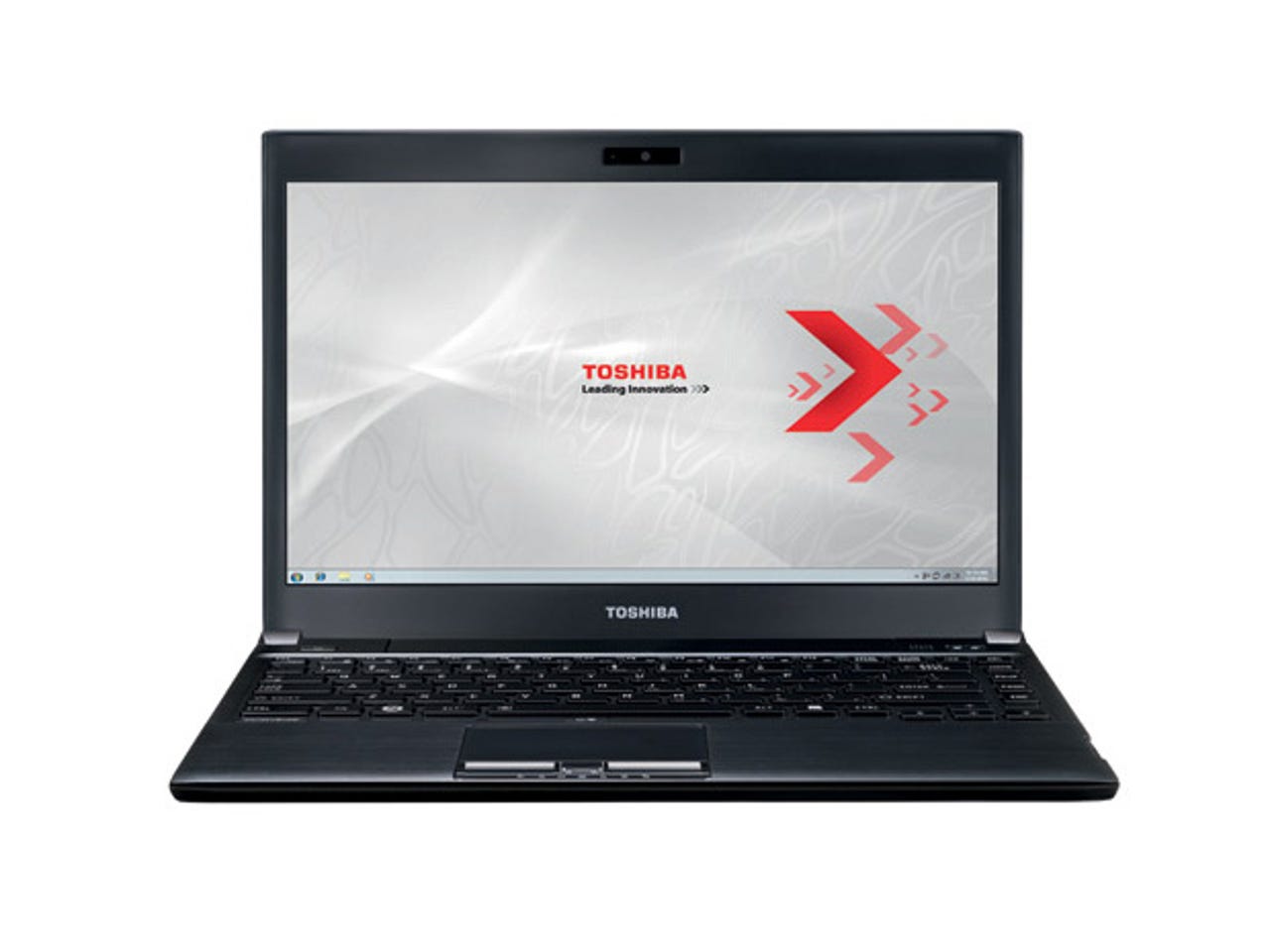Toshiba Portégé R830-138


Toshiba Portégé R830-138
Toshiba's ultraportable Portégé line has a strong pedigree. Last year's Portégé R700 scored well thanks to a combination of neat design, good battery life, light weight and generally good performance. The Portégé R830 looks very similar to its predecessor, adding updated components.
Like the R700, though, the R830 can be pricey. The entry-level Core i3 model costs £949 (ex. VAT), while the top-end Core i7 version comes in at £1,599 (ex. VAT). We reviewed the mid-range Core i5-based R830-138 model, which costs £1,199 (ex. VAT).
Design
The Portégé R830's chassis looks like it's made of black plastic, but closer inspection reveals a magnesium alloy construction. The lid is too flexible for our liking — you don't have to press very hard to distort the screen. Nor is there a clasp to hold the lid and base together solidly in transit. The R700 had the same issues. We regularly carry the older model as it's our everyday computer, but always in a solid protective case.
The R830 will appeal to mobile professionals who need to minimise the bulk and weight of their notebooks. Measuring 31.6cm wide by 22.7cm deep by 1.83-2.66cm thick, it's small enough to fit into even quite tiny backpacks. At 1.48kg, the R830 is actually a little heavier than its R700 predecessor, which started at 1.28kg — but that's because some R700 models lack an optical drive.
All four current R830 models have an optical drive, which indicates — as we have long suspected — that few people buy notebooks (even ultraportable ones) without optical drives. We may not necessarily use the drives that often, but external units are a nuisance and you never know when you'll need an optical drive.
The 13.3in. Portégé R830 comes with Core i3, i5 or i7 Sandy Bridge processors and up to 8GB of RAM; all models have an integrated optical drive
Inside, the Portégé R830 is indistinguishable from its predecessor. Comparing the two models side by side, we can't see any difference between them. The chiclet-style keyboard is very slightly spongier on the R830, but we found it comfortable to use at speed. Anyone who likes a lot of travel from their keyboard may be less satisfied, though.
Beneath the keyboard is a large touchpad with a small on/off button beneath the space bar that disables it. If you've not had the ability to turn a notebook's touchpad off before, you'll appreciate this very useful feature: it's easy to brush the touchpad with the palm accidentally when typing for extended periods.
The touchpad incorporates vertical and horizontal scroll zones and supports multitouch gestures such as pinch-to-zoom when viewing web pages. A fingerprint sensor sits between the two touchpad buttons.
The power switch is on the left, above the row of number keys, while on the right are two small buttons. One activates the Toshiba Eco Utility, a configurable software tool that helps you conserve power consumption and increase battery life. The second small button invokes Intel Wireless Display, for sharing your notebook's screen with other appropriately equipped displays, including TVs. Note, though, that you may need an adapter for the external devices.
The R830's 13.3in. screen is matte rather than reflective, and has an LED backlight that delivers a bright enough display for many circumstances — even when using the preset Eco mode configuration. The screen's 1,366-by-768 pixel resolution is standard fare. Viewing angles are good but not great, and slightly better in the horizontal plane than the vertical. All R380 models have a VGA-resolution webcam sitting in the middle of the upper screen bezel.
Features
The Toshiba Portégé R830 range is powered by Intel's Sandy Bridge processors. Our review sample was based on a 2.5GHz Core i5-2520 chip. The top-end model has a 2.7GHz Core i7-2620, while the entry-level model uses a 2.1GHz Core i3-2310. Our review unit came with 4GB of 1,333MHz DDR3 RAM, expandable to 8GB. The operating system is Windows 7 Professional 64-bit.
Graphics are handled by Intel's CPU-integrated HD Graphics 3000 on all R830 models. For storage our review sample had a 500GB hard drive spinning at 7,200rpm; in the entry-level model this drops to 320GB, while the top-end R830 has a speedy, low-power 128MB SSD.
Connectivity options are very good, starting with Gigabit Ethernet. On the wireless side there's Wi-Fi, (802.11a/b/g/n), the aforementioned Intel Wireless Display, Bluetooth (3.0) and mobile broadband. The SIM card slot is underneath the battery; HSPA data transfer speeds are 14.4Mbps down and 5.76Mbps up; HSPA+ is also supported with download speeds up to 21Mbps.
For an ultraportable notebook, the Portégé R830 has a decent set of ports and connectors. On the right edge the optical drive sits towards the front of the chassis. Directly above it, readily accessible with its slot on the wrist rest, is an SD card reader. Behind it are headphone and microphone jacks, and behind these a single USB 3.0 connector. At the very back is the RJ-45 Ethernet port.
The left edge houses an HDMI connector, a second USB port (this time USB 2.0) and a USB 2.0/eSATA combo port supporting USB sleep and charge. Behind this trio is the external monitor connector, and behind this the cooling vent.
Toshiba packs the R830 with software, some of which seems entirely inappropriate for a business system — the WildTangent games console, for example, is an online games portal. There are also web links to eBay and Amazon.
On the other hand, Toshiba Face Recognition offer an alternative secure login to the fingerprint sensor or a Windows password; there's aldo a time-limited version of McAfee Internet Security and the function-limited ad-supported versions of Word and Excel that form Office Starter 2010.
Toshiba also includes its Eco Utility, Bulletin Board and ReelTime applications. Bulletin Board is a graphically rich place to keep notes and links, which could be useful for managing various kinds of project, while ReelTime is an indexing system that helps you find recent documents. Both are pinned to the taskbar.
Performance & battery life
The Portégé R830's overall Windows Experience Index (WEI) score is a moderate 4.6 out of 7.9. This corresponds to the lowest component score, which was for Graphics (desktop performance for Windows Aero). The remaining component scores are more than respectable: 5.9 for RAM (Memory operations per second) and Primary hard disk (Disk data transfer rate), 6.1 for Gaming Graphics (3D business and gaming graphics performance) and 7.1 for Processor (calculations per second).
Mainstream document creation and media consumption workloads are likely to be the Portégé R830's standard fare, and it's well equipped to handle these.
Although Toshiba claims up to 15 hours battery life for the Portégé R830 in the summary part of its web site, examine the specifics for each model reveals a more modest 8 hours and 55 minutes for the standard 6-cell battery shipped with our review unit.
We tested this by playing a DVD movie continuously. We chose the 'eco' power scheme, which results in a screen brightness rather too low for comfort, so we turned this up a little (but left the remaining settings alone). Under these conditions the Portégé R830 delivered 5 hours and 10 minutes of movie playback. That's an hour longer than we got from the R700, but in the latter case we were obliged to use a USB stick for video delivery as our review sample lacked an optical drive.
Speakers are located above the row of number keys. They deliver quite loud volume, but the audio quality is lacking in bass and therefore sounds somewhat tinny.
During last year's review we noticed that the Portégé R700 got a little warm underneath the cooling vent. Thankfully this does not seem to be the case with the R830.
Conclusion
Toshiba has updated the Portégé R700 with new components but retained the old chassis design. We'd prefer a more solid lid section, but the R830 is an impressively portable notebook. Battery life is good too, but the cost remains high.